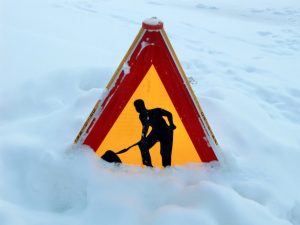Personal injury Lawyer Matt Arnold answers the question: ” I have been injured on another person’s property. What should I do now?”
Given the recent winter weather across not only North Carolina, but 49 of 50 states (Florida is the only one without any snow on the ground, even Hawaii has something), the potential for slipping and falling has increased rather dramatically. Studies have shown that more accidents happen in the winter and property owners are often especially worried about the possibility of someone hurting themselves, fearing liability for the injuries that result from an unsuspecting accident. How does this work when it comes to snow and ice? Are the property owners always on the hook?
 The first thing to mention is that state and local laws can impact a property owner’s liability in the event of dangerous winter weather. In some states, like Massachusetts, the law used to clearly state that property owners were not liable for accidents that arose due to natural accumulations of ice or snow. However, the law changed a few years ago and now Massachusetts residents are liable if they fail to take “reasonable steps” to remove ice and snow from areas where visitors or the general public might travel.
The first thing to mention is that state and local laws can impact a property owner’s liability in the event of dangerous winter weather. In some states, like Massachusetts, the law used to clearly state that property owners were not liable for accidents that arose due to natural accumulations of ice or snow. However, the law changed a few years ago and now Massachusetts residents are liable if they fail to take “reasonable steps” to remove ice and snow from areas where visitors or the general public might travel.
Beyond the impact of state and local laws, property owners are frequently made liable due to the general doctrine of negligence. The idea behind negligence is that a person can be liable for failing to behave reasonably, even if a law isn’t specifically on point. If, for instance, it can be argued that a reasonable property owner would have realized the danger of the ice or snow accumulation and taken steps to mitigate that danger, a failure to do so might result in legal liability.
To bring a successful claim against a property owner, the victim will need to show a few things. First, that there was a dangerous condition present on the property (the snow and ice will do the trick). Second, that the condition was such that the owner of the property knew or should have known that the dangerous condition existed. Third, the owner will need to be shown to have failed to correct the dangerous condition. Finally, the victim will need to show that the condition resulted in injury. If all these things are proven to the satisfaction of a court, the property owner might very well be held responsible.
One thing to keep in mind, especially in North Carolina, is the issue of contributory negligence. This rule is very defendant-friendly and says that if the plaintiff in a case is found to bear any responsibility for the underlying accident, then he or she cannot recover any damages from the defendant. In the case of a winter slip-and-fall, that means if the person who fell on a patch of ice wasn’t looking where he was going or was wearing inappropriate footwear, enough that he or she bears some of the blame, that may be all it takes to shield the property owner from an expensive personal injury lawsuit.
If you or someone close to you has been injured, contact an experienced personal injury attorney today who can help you receive the compensation to which you may be entitled. Contact Arnold & Smith, PLLC for a free consultation, call at 704-370-2828 or click here for additional resources.
About the Author
 Matthew Arnold is a Managing Member of Arnold & Smith, PLLC, where he focuses on the areas of family law, divorce, child custody, child support, alimony and equitable distribution.
Matthew Arnold is a Managing Member of Arnold & Smith, PLLC, where he focuses on the areas of family law, divorce, child custody, child support, alimony and equitable distribution.
Mr. Arnold was raised in Charlotte, where he graduated from Providence Senior High School. He attended Belmont Abbey College, where he graduated cum laude, before attending law school at the University of North Carolina at Chapel Hill on a full academic scholarship.
A board-certified specialist in the practice of Family Law, Mr. Arnold is admitted to practice in all state courts in North Carolina, in the United States Federal Court for the Western District of North Carolina, in the North Carolina Court of Appeals and Supreme Court, and in the Fourth Circuit United States Court of Appeals in Richmond, Virginia.
In his free time, Mr. Arnold enjoys golfing and spending time with his wife and three children.
Source:
http://myfox8.com/2017/01/09/snow-related-injury-liability-who-is-at-fault/
Image Credit:
http://www.freeimages.com/photo/a-sign-in-the-snow-1057896
See Our Related Video from our YouTube channel:
https://www.youtube.com/user/ArnoldSmithPLLC/videos
See Our Related Blog Posts:
 Charlotte Injury Lawyers Blog
Charlotte Injury Lawyers Blog

